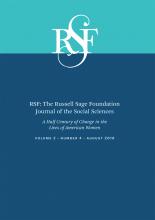Research Article
Open Access
Advances and Ambivalence: The Consequences of Women's Educational and Workforce Changes for Women's Political Participation in the United States, 1952 to 2012
Ashley Jardina, Nancy Burns
RSF: The Russell Sage Foundation Journal of the Social Sciences August 2016, 2 (4) 272-301; DOI: https://doi.org/10.7758/RSF.2016.2.4.10
Ashley Jardina
aAssistant professor of political science in the Department of Political Science at Duke University
Nancy Burns
bWarren E. Miller Collegiate Professor and chair in the Department of Political Science at the University of Michigan

REFERENCES
- ↵
- Acemoğlu, Daron, and
- Joshua Angrist
- ↵American National Election Studies (ANES). Time Series Cumulative Data File [dataset]. 2012. Stanford University and the University of Michigan [producers and distributors]. Accessed April 9, 2016. http://www.electionstudies.org/studypages/anes_timeseries_cdf/anes_timeseries_cdf.htm.
- ↵
- Bailey, Martha J., Melanie Guldi, and Brad J. Hershbein. 2014. “Is There a Case for a ‘Second Demographic Transition?’ Three Distinctive Features of the Post-1960 US Fertility Decline.” In Human Capital in History: The American Record, edited by Leah Platt Boustan, Carola Frydman, and Robert A. Margo. Chicago: University of Chicago Press.
- ↵Belkin, Lisa. 2003. “The Opt-Out Revolution.” New York Times Magazine, October 26. doi:10.1002/mde.1290. Accessed April 9, 2016. http://www.nytimes.com/2003/10/26/magazine/26WOMEN.html?pagewanted=all.
- ↵
- ↵Bertrand, Marianne. 2011. “New Perspectives on Gender.” In Handbook of Labor Economics, vol. 4b, edited by David Card and Orley Ashenfelter. San Diego: Elsevier Science. doi:10.1016/S0169-7218(11)02415-4.
- ↵Blau, Francine D., and Lawrence M. Kahn. 2005. “Changes in the Labor Supply Behavior of Married Women: 1980–2000.” NBER working paper no. 11230. Cambridge, Mass.: National Bureau of Economic Research.
- ↵Card, David. 1993. “Using Geographic Variation in College Proximity to Estimate the Return to Schooling.” NBER working paper no. 4483. Cambridge, Mass.: National Bureau of Economic Research.
- ↵
- Correll, Shelley J
- ↵
- Dee, Thomas S
- ↵Dobbin, Frank. 2009. Inventing Equal Opportunity. Princeton, N.J.: Princeton University Press.
- ↵
- Farre, Lidia, and
- Francis Vella
- ↵
- Fortin, Nicole M
- ↵Gerson, Kathleen. 2011. The Unfinished Revolution: Coming of Age in a New Era of Gender, Work, and Family. New York: Oxford University Press.
- ↵
- Goffman, Erving
- ↵
- Goldin, Claudia
- ↵Goldin, Claudia. 2006. “The Quiet Revolution That Transformed Women's Employment, Education, and Family.” NBER working paper no. 11953. Cambridge, Mass.: National Bureau of Economic Research.
- ↵
- ↵
- Goldin, Claudia, and
- Lawrence F. Katz
- ↵
- ↵
- ↵Jennings, M. Kent, and Richard G. Niemi. 1981. Generations and Politics: A Panel Study of Young Adults and Their Parents. Princeton, N.J.: Princeton University Press.
- ↵
- Kam, Cindy D., and
- Carl L. Palmer
- McLanahan, Sara
- ↵
- ↵Rosenstone, Steven J., and John M. Hansen. 1993. Mobilization, Participation, and Democracy in America. New York: Macmillan.
- Schaffner, Brian, and Stephen Ansolabehere. 2015. CCES Common Content, 2014. Harvard Dataverse, V2. doi:10.7910/DVN/XFXJVY.
- ↵Schlozman, Kay Lehman, Sidney Verba, and Henry E. Brady. 2013. The Unheavenly Chorus: Unequal Political Voice and the Broken Promise of American Democracy. Princeton, N.J.: Princeton University Press.
- Smith, Aaron. 2013. “Civic Engagement in the Digital Age.” Washington, D.C.: Pew Research Center. Accessed March 31, 2016. http://www.pewinternet.org/2013/04/25/civic-engagement-in-the-digital-age-2/.
- Smith, Aaron, Kay Lehman Schlozman, Sidney Verba, and Henry Brady. 2009. “The Internet and Civic Engagement.” Washington, D.C.: Pew Research Center. Accessed March 31, 2016. http://www.pewinternet.org/2009/09/01/the-internet-and-civic-engagement/.
- Smith, Tom W., Peter Marsden, Michael Hout, and Jibum Kim. 2015. General Social Surveys, 1972-2014. Chicago: NORC at the University of Chicago; Storrs, Conn.: The Roper Center for Public Opinion Research, University of Connecticut.
- ↵
- Sondheimer, Rachel M., and
- Donald P. Green
- ↵
- Spence, Janet T., and
- Robert Helmreich
- ↵Stevenson, Betsey, and Justin Wolfers. 2009. “The Paradox of Declining Female Happiness.” NBER working paper no. 14969. Cambridge, Mass.: National Bureau of Economic Research.
- ↵Stone, Pamela. 2007. Opting Out?: Why Women Really Quit Careers and Head Home. Berkeley: University of California Press.
- ↵
- ↵
- Thornton, Arland,
- Duane F. Alwin, , and
- Donald Camburn
- ↵U.S. Census Bureau. 2011. “More Working Women Than Men Have College Degrees, Census Bureau Reports.” News Release CB11-72. Washington: U.S. Department of Commerce. Accessed April 0, 2016. https://www.census.gov/newsroom/releases/archives/education/cb11-72.html.
- ↵U.S. Census Bureau. 2014. “Annual Social and Economic Supplement of the Current Population Survey.” Washington: U.S. Department of Commerce. Accessed April 9, 2016. https://www.census.gov/did/www/saipe/data/model/info/cpsasec.html.
- ↵Verba, Sidney, Kay Lehman Schlozman, and Henry E. Brady. 1995. Voice and Equality: Civic Voluntarism in American Politics. Cambridge, Mass.: Harvard University Press.
- Verba, Sidney, Kay Lehman Schlozman, Henry E. Brady, and Norman Nie. 1995. American Citizen Participation Study, 1990. ICPSR06635-v1. Ann Arbor, Mich.: Inter-university Consortium for Political and Social Research. doi:10.3886/ICPSR06635.v1.
In this issue
Advances and Ambivalence: The Consequences of Women's Educational and Workforce Changes for Women's Political Participation in the United States, 1952 to 2012
Ashley Jardina, Nancy Burns
RSF: The Russell Sage Foundation Journal of the Social Sciences Aug 2016, 2 (4) 272-301; DOI: 10.7758/RSF.2016.2.4.10
Advances and Ambivalence: The Consequences of Women's Educational and Workforce Changes for Women's Political Participation in the United States, 1952 to 2012
Ashley Jardina, Nancy Burns
RSF: The Russell Sage Foundation Journal of the Social Sciences Aug 2016, 2 (4) 272-301; DOI: 10.7758/RSF.2016.2.4.10
Jump to section
Related Articles
- No related articles found.
Cited By...
- No citing articles found.





